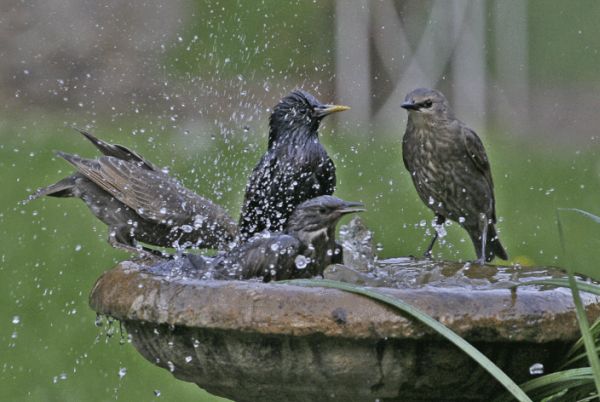
European starlings are common in my neighborhood.
They nest in the eaves of my neighbor’s house, having evicted the house sparrows who used that hole in prior years. It’s a form of weird justice that one invasive species displaced another in the cut-throat world of nest site competition.
This morning I learned that the starlings were successful. I could tell their first brood had fledged by the sound: churrrr, churrrr, churrrr, churrrr.
Fledgling starlings are a dull brown color with almost no variation except for a dark mask from beak to eyes. The first time I saw one I thought it was a new species until it begged from an adult starling. Churrrr, churrrr, churrrr. No doubt about it. That dull brown bird was a baby.
Young starlings begin to molt into starry winter plumage when they are only 4-6 weeks old so you’ll have to look now if you want to see them in their dull brown feathers. In the photo above, three juveniles are taking a bath with one adult (he has the yellow beak). Notice how dull the back is on the bird at left. You can almost see the mask on the bird at right.
Listen for the fledglings and you’ll find them easily. After a while the sound is annoying.
Churrrr, churrrr, churrrr.
(photo from Wikipedia under Creative Commons license. Click on the photo to see the original.)
p.s. June 30: The starlings have fledged their second brood in my neghborhood. I hear “churrr, churrr” again.
It still amazes me when I watch the starlings to think that the 200 million or so in North America all descended from about 60 birds in central park, more or less – all because one guy wanted to introduce every bird mentioned by Shakespeare.
Thanks to his efforts, I found myself sitting in a sunny patch of grass beneath the cathedral of learning at lunch time last week surrounded by several starlings. One of the birds landed nearby and began rummaging through the grass looking for insects. The nice guy that I am, I tossed it a bit of bread from my sandwich. She (or he) picked up the bread, tossed it around for a second, and then decided it wasn’t to her liking. So I tossed her a corner of provolone cheese. She instantly picked it up and began carrying it around in her beak, without eating any of it. She continued like this for several minutes, even pecking at more moths and other insects in the grass, the cheese protruding from both sides of her beak as she pecked. I thought maybe the cheese had become stuck to her. However, the second the thought occurred to me, she dropped the cheese and snapped at a moth that suddenly took flight. She then immediately went back to the cheese and picked it up exactly as before. She proceeded to hunt lunch for a good 3 minutes, occasionally dropping the cheese to eat an insect before picking it back up. Finally she looked up at me, cheese sticking out almost twice the size of her head, and took flight. I presume this to mean she preferred to eat her cheesy dessert in private. Or maybe feed her chicks. Or decorate her nest. Who knows, really. It’s yet another mystery destined to forever remain unresolved.